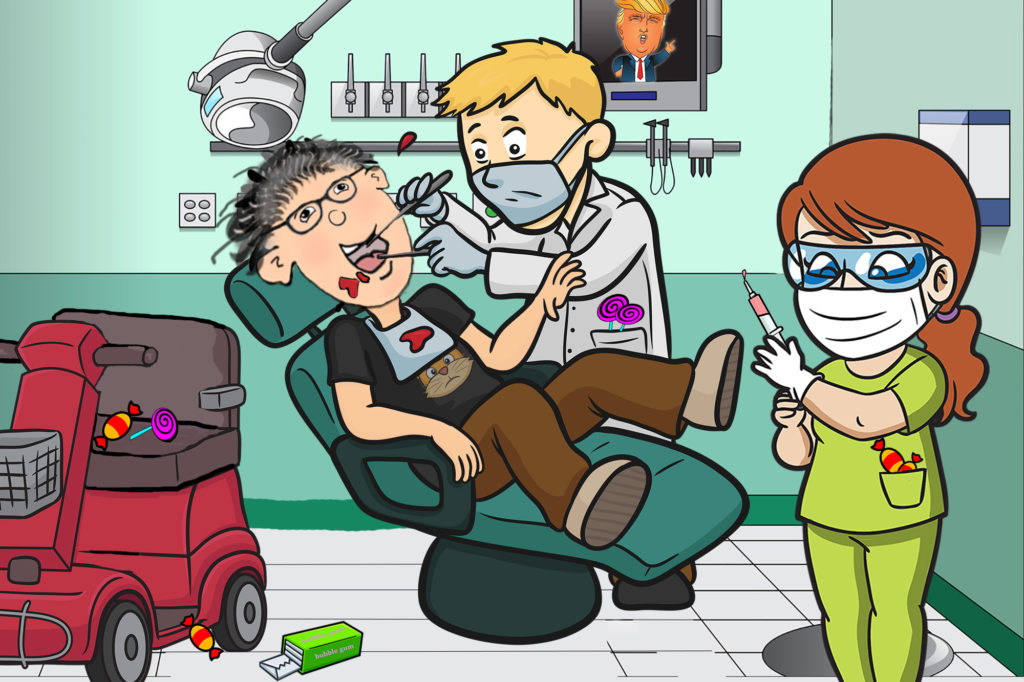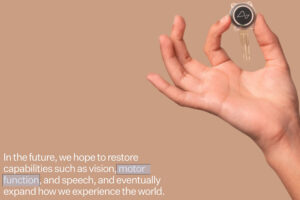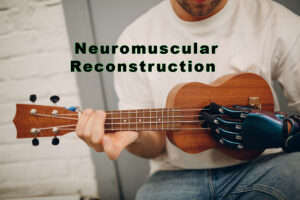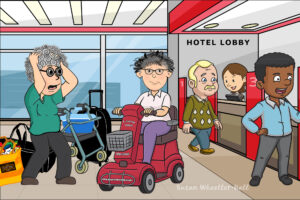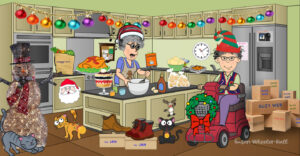In case you don’t already know, I live my life with a disability that affects the way I walk and my ability to get around.
Many people who meet me wonder what has happened – have I been in an accident, or been afflicted with a severe back injury?
When people inquire, I usually tell them that I have a progressive neuromuscular disease, and prefer to leave it at that.
Actually, I have CMT, which stands for Charcot-Marie-Tooth – and NO, it has nothing to do with teeth. It’s a progressive genetic disease that I inherited from my late mother. It’s a disease that affects families; I have one brother with it, and another who does not.
I try not to get into what “Charcot-Marie-Tooth” is, simply because it really makes no sense as a stand-alone name, and can often cause confusion.
When people hear the last word, “tooth”, they often ask: “How can a tooth disease impair your ability to walk?”
At this point, I explain that Charcot-Marie-Tooth, is a combination of the names of the three doctors who originally described it.
Personally, I think these doctors must have had large egos. It’s one thing to put your name on a library or medical building, but a disease? …well, I just don’t get it.
That said, once we move past the name, the next hurdle is, “I’ve never heard of it, it must be rare”.
Oddly enough, it is not rare, as 1 in 2500 people experience this condition.
In fact, it is considered to be quite a common peripheral neuropathy – meaning that it’s a condition that affects the nerves in the body – mainly those that power the muscles, rather than in the brain.
Unfortunately, I still encounter physicians and health care providers who have either, not heard of the condition, or know of it and have not met a patient with the condition.
For those who do have some knowledge of CMT they are further perplexed, because, to their mind, I don’t fit the profile.
My symptoms affect my physical abilities far more than what is considered to be typical of a patient with CMT.
This is where we get technical – or scientific if you prefer.
There are several forms or types of CMT, and the most commonly recognized are CTM1, CMT1A and CMT1B.
These types vary in onset and severity but are characterized by slowly progressive muscle weakness, atrophy, and changes in sensation – and generally, the condition affects the feet, lower legs, hands, and forearms.
This group tends to experience what is known as foot drop. Affected individuals tend to have an over-exaggerated step where they lift their foot higher than normal to avoid tripping. They also often have high-arched feet (what they call pes cavus), and may also experience some numbness.
It’s not unusual for people with this type of CMT to not know they have the condition until later in life, and this may occur after they themselves have had children.
Through research, more types of CMT continue to be identified. We now have CMT1, CMT2, CMT4, and CMTX-6. I’m not familiar with CMT3 and CMT5 but they do exist, as well as CMTDI, CMTRI, CMTX – apparently we’re up to nine genetic subtypes!
Types: CTM1 now ranges from CMT1A- CMT1F, CMT2 ranges from CMT2A-CMT2E, CMT4 ranges from CMT4A-CMT4J, and CMTX, also known as CMTX-6 stands alone and is linked to the X chromosome and affects males more severely than females.
The more we understand the underlying genetics – the more we are able to separate them into different types. Suffice to say it’s all a bit complicated.
The bottom line though, is the higher the CMT type number, the more likely symptoms will be more severe, the onset will be earlier, areas affected may be larger, and progression – faster.
Recent studies also show that CMT, as an inherited genetic disease, can affect people quite differently, even those diagnosed within a specific type. My brother and I were diagnosed with CMT2E but we also have differences in our disease expression.
Unfortunately, as yet, there is NO cure for this progressive disease. Nonetheless, the growth in scientific knowledge – particularly in the field of genetics, over the past two decades has been very promising, and thankfully, there are some dedicated organizations that continue to push for research.
In my own way, I humbly thank them.
So, what do I tell people?
When asked, I filter my answer based on careful discernment. My response will depend on; who’s asking, why are they are asking, and frankly, what’s in for me.
For example, a medical professional, business acquaintance, a new friend, or a total strange will all get different answers.
Medical professionals get the whole enchilada, as I know it. It’s my chance to impress them with my knowledge. I also get the chance to tell the story about how I was treated as an investigative guinea pig as a child. I can’t count the number of times groups of doctors in white coats stood around me while I sat in my underpants, being pushed, poked and prodded and hit with tiny rubber hammers.
Business acquaintances, on the other hand, get enough information to know that my capabilities are greater than my challenges.
In a customer service situation, I provide clear problem-solution information. For example, when arranging a hotel stay, I alert staff to my impairment challenges and tell them the accommodations I require to ensure my safety, comfort, and satisfaction are not compromised.
New friends get the basics, but receive more information as our relationship develops. And total strangers, well they receive a vague acknowledgment followed by a comment about the weather in an effort to gracefully change their focus.
Okay, now that we’re friends, after all, you’ve read this far, I’ll explain how CMT affects me.
My progression continues, but at this point – my walking is very limited and aided by a walker, I use a scooter, drive with hand controls, type with three fingers, require a breathing ventilator at night, wear AFO’s (leg braces) have poor circulation and swelling of the feet. I also have occasional challenges swallowing, and vocal muscle paralysis which leaves me with a soft, quiet and (so I’m told) sexy voice.
Over the years, I’ve learned that how I talk about my experience with CMT is more important than the name itself.
Living well when unwell is challenging but it is also possible. In fact, I teach a 6 week online facilitated course, 4 times a year, on just that. Maybe you’d like to join me for the next one at (http://livingwellwhenunwell.com), or connect with me for other methods of support at my home site here (https://susanwheelerhall.com). I’d love to chat!
And, if you’d like to learn more about CMT then I’d recommend you visit the Hereditary Neuropathy Foundation website, they do a great job of providing information for both physicians and patients.

